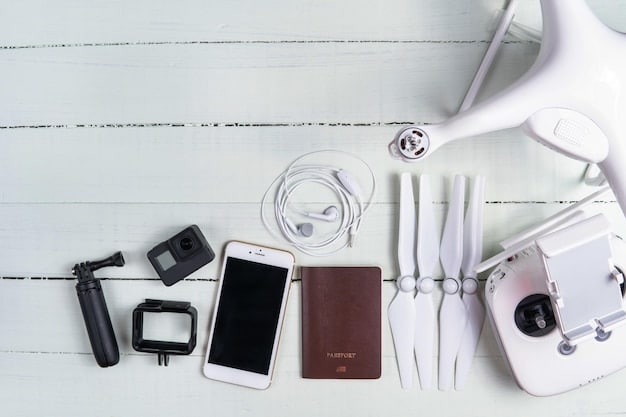How to Pack for a Cross-Country US Trip: 2025 Guide

Preparing for a cross-country US trip in 2025 involves strategic packing, focusing on essential items, versatile clothing, and utilizing space efficiently to ensure comfort, convenience, and safety throughout the journey.
Embarking on a cross-country adventure across the United States is an exhilarating prospect, promising diverse landscapes, vibrant cities, and unforgettable experiences. However, the success and enjoyment of such a journey often hinge significantly on meticulous planning, particularly concerning what you bring along. This comprehensive guide, “How to Pack for a Cross-Country US Trip: A Practical Guide for 2025,” aims to demystify the packing process, ensuring you are well-prepared for the unexpected while optimizing comfort and convenience for the road ahead.
Understanding the Dynamics of a Cross-Country Trip
A journey across the United States is not a monolithic experience. It encompasses extreme variations in climate, terrain, and activity potential. Consequently, your packing strategy must be as dynamic as the route itself. Unlike a single-destination vacation, a cross-country trip demands foresight regarding diverse environments, from arid deserts to humid coastal regions, and from bustling urban centers to serene natural parks.
Considering the length of your trip, the modes of transportation, and the activities planned at various stops are crucial first steps. Are you primarily driving, or will flights and train travel be part of the itinerary? Will you be camping, staying in hotels, or a mix of both? Each of these factors significantly influences the type and quantity of items you should consider packing. Moreover, anticipating potential weather shifts and regional specialties, such as unique dining experiences or cultural events, can help you tailor your wardrobe and gear accordingly.
Assessing Your Travel Style and Itinerary
Your personal travel style plays a significant role in determining what to pack. Minimalists might opt for a single carry-on, while those who prefer more creature comforts might bring multiple bags. The key is to find a balance that suits your needs without overpacking, which can lead to unnecessary bulk and stress. An organized itinerary, even a loose one, can guide your packing decisions by highlighting specific needs for certain segments of the journey.
- Road tripper: Maximize car space, prioritize comfort and accessibility for items needed on the go.
- Urban explorer: Focus on stylish yet comfortable walking shoes and layering options for city weather.
- Nature enthusiast: Include specialized gear for hiking, camping, or water activities, considering durability.
- Mix of everything: Emphasize versatility and multi-functional items to adapt to various scenarios.
Ultimately, a successful cross-country packing strategy begins with a clear understanding of the journey’s scope and a realistic assessment of your personal travel habits and preferences. This foundational knowledge will serve as your compass throughout the entire packing process, helping you make informed decisions about every item that finds its way into your luggage.
Clothing and Apparel: Versatility is Key
Packing clothes for a cross-country trip is perhaps the most challenging aspect, given the vast climatic differences you might encounter. The secret lies in versatility and layering. Instead of packing outfits for specific days, think about individual pieces that can be mixed and matched to create multiple looks and accommodate varying temperatures. Merino wool, for example, is an excellent choice for its temperature-regulating properties, odor resistance, and quick-drying nature.
Consider the “three-thirds rule”: pack enough clothes so that you can wear one-third, have one-third in the wash, and one-third still clean. For a trip lasting several weeks, this might translate to 5-7 tops, 3-4 bottoms, 2-3 outer layers, and sufficient underwear and socks for about a week, with planned laundry stops. This approach minimizes bulk while ensuring you always have clean attire available. Remember, laundry facilities are widely available across the US, from laundromats to hotel services.
Strategic Outerwear and Footwear Choices
Outerwear should offer protection against both rain and cold. A lightweight, waterproof jacket is indispensable, regardless of the season. Pair it with a versatile fleece or a packable puffy jacket for warmth. For footwear, comfort and durability are paramount. You’ll likely be doing a lot of walking, so invest in at least two pairs of comfortable walking shoes. One pair of versatile sneakers and one pair of more robust hiking shoes or boots, depending on your itinerary, usually suffice.
- Waterproof shell: Essential for unexpected rain in any climate.
- Mid-layer fleece/puffy: Provides warmth without excessive bulk.
- Comfortable walking shoes: Your primary footwear for daily activities.
- Casual/dressier alternative: For nights out or specific events.
- Flip-flops/sandals: For hotel rooms, beach, or quick errands.
Selecting appropriate clothing and footwear is not just about comfort; it’s also about preparedness. By opting for versatile, layering pieces, you can significant reduce the amount of luggage you haul while ensuring you’re ready for whatever weather or activity comes your way.

Essential Toiletries and Personal Care Items
While most toiletries can be purchased along the way, having your essentials readily available saves time and ensures you have your preferred brands. Prioritize a basic dental kit, compact shampoo, conditioner, soap, and any prescription medications. Remember to pack these in travel-sized containers to conserve space and comply with airline liquid regulations if you plan on flying at any point.
Consider multi-use products like two-in-one shampoo and conditioner, or a solid soap bar that can serve for both body and laundry. Sunscreen and insect repellent are non-negotiable, especially when traversing diverse outdoor environments. A small first-aid kit with band-aids, antiseptic wipes, pain relievers, and any personal allergy medications is also highly recommended for minor mishaps.
Beyond the Basics: Health and Hygiene
For longer trips, consider a small, quick-drying towel. While many accommodations provide towels, having your own can be useful for spontaneous dips in lakes or emergency cleanups. Hand sanitizer is also a must-have, particularly when access to soap and water is limited. Don’t forget personal comfort items like lip balm, moisturizer, and specific hair care products that are hard to find on the road.
- Travel-sized toiletries: Optimize space and adhere to TSA regulations.
- Sunscreen and insect repellent: Crucial for outdoor protection.
- Basic first-aid kit: For immediate care of minor injuries.
- Prescription medications: Ensure enough supply for the entire trip, plus a buffer.
- Hand sanitizer: For convenience and hygiene on the go.
Packing smart means anticipating your needs without overdoing it. A well-stocked yet compact toiletry bag can make a significant difference in your daily comfort and preparedness, allowing you to focus on the journey rather than searching for forgotten items.
Gadgets and Electronics: Staying Connected and Entertained
In our increasingly connected world, electronics have become integral to travel. A smartphone is virtually indispensable for navigation, communication, capturing memories, and accessing information. Beyond that, consider what other devices truly enhance your trip without becoming a burden. A portable power bank is a lifesaver for keeping devices charged on the go, especially during long drives or remote camping. Don’t forget car chargers and appropriate adapters if renting a vehicle.
For entertainment, a tablet or e-reader can provide hours of distraction during downtime. A camera beyond your phone’s capabilities might be worthwhile if photography is a significant part of your travel experience. Remember all necessary charging cables, and consider a multi-port USB charger to reduce the number of wall adapters you need to carry.
Managing Power and Connectivity
Even with careful planning, power outlets can be scarce. Investing in a power inverter for your car allows you to charge laptops and other larger electronics while driving. Mobile hotspots or understanding your phone’s tethering capabilities can provide internet access in areas with weak Wi-Fi signals. Earbuds or noise-canceling headphones are excellent for blocking out road noise or enjoying audio entertainment without disturbing others.
- Smartphone + car mount: For GPS, music, and communication.
- Portable power bank: Essential for keeping devices charged off-grid.
- Multi-port USB charger: Efficiently charge multiple devices simultaneously.
- E-reader/tablet: For entertainment during downtime.
- Headphones: For personal audio or noise cancellation.
Finding the right balance of gadgets ensures you stay connected, entertained, and on track without feeling overwhelmed by an excessive amount of tech. Prioritize items that offer genuine utility and enhance your travel experience.

Important Documents and Financial Preparedness
While often overlooked in the excitement of packing, securing your essential documents and ensuring financial readiness is paramount. Your driver’s license, vehicle registration, and insurance cards are non-negotiable for a road trip. Keep them easily accessible. For identification, a secondary form like a passport or state ID is also advisable. Make photocopies or digital backups of all critical documents and store them separately from the originals.
Financial preparedness means carrying a mix of payment methods. Relying solely on credit cards can be risky if one is lost or compromised. Carry at least two different credit cards from different networks (e.g., Visa and MasterCard), as well as a debit card for cash withdrawals. Inform your banks of your travel plans to prevent transaction flags. A small amount of cash for tolls, parking meters, or small purchases from vendors who don’t accept cards is also wise.
Emergency Preparedness and Accessibility
Beyond standard documents, consider an emergency contact list, both physical and digital. If you have medical conditions, carry relevant medical information, including a list of medications and dosages. For roadside assistance, ensure you have your membership details or relevant contact numbers. Having these details readily available can significantly reduce stress in unexpected situations.
- Driver’s license, registration, insurance: Essential for driving legality.
- Multiple payment methods: Credit cards, debit card, and some cash.
- Digital and physical document backups: For security against loss.
- Emergency contact list: For immediate access in urgent situations.
- Health information (if applicable): Crucial for medical emergencies.
Proper documentation and financial planning ensure peace of mind and smooth handling of any unforeseen circumstances. Taking the time to organize these details before you depart is an investment in a stress-free journey.
Packing Strategies and Space Optimization
Once you’ve decided what to bring, the next step is how to pack it efficiently. Space optimization is crucial for a cross-country trip, especially if you have limited vehicle space or are sharing with others. Rolling clothes tightly instead of folding them is a time-tested technique to minimize wrinkles and maximize space. Packing cubes are another game-changer, allowing you to compartmentalize your belongings by type, outfit, or activity, making it easier to find what you need without unpacking everything.
Consider the “personal item” for a road trip: a small bag or backpack that stays within reach in the car. This bag should contain items you’ll need frequently, such as snacks, water, phone charger, basic toiletries, a book, and important documents. This prevents constant rummaging through larger suitcases in the trunk.
Smart Organization for the Road
For items like shoes, use shower caps or plastic bags to prevent dirt from transferring to clean clothes. Utilize the inside of your shoes for small items like socks or chargers. For electronics, a dedicated tech organizer keeps cables, adapters, and smaller gadgets tidy and accessible. Consider a collapsible laundry bag to keep dirty clothes separate and compressed.
- Rolling clothes: Maximizes space and reduces wrinkles.
- Packing cubes: Organizes items and compresses air.
- Personal “grab-and-go” bag: Keeps essentials easily accessible in the car.
- Smart storage for shoes: Prevents dirt transfer.
- Dedicated tech organizer: Keeps electronics and cables tidy.
Effective packing isn’t just about fitting everything; it’s about making your trip smoother and more enjoyable. By employing these strategies, you can reduce clutter, save time, and minimize frustration while on the road, leaving more room for adventure.
Vehicle Preparedness and Emergency Kit
While packing for yourself is important, preparing your vehicle for a cross-country journey is equally critical. Regular maintenance, including oil changes, tire checks, and fluid top-ups, should be completed before departure. Beyond routine checks, having an emergency kit in your car can be a lifesaver, especially when traveling through remote areas where assistance may be hours away.
A basic car emergency kit should include jumper cables, a spare tire (properly inflated), a jack and lug wrench, a flashlight with extra batteries, a basic toolkit, and reflective triangles or flares. Consider adding a small shovel or traction mats if you anticipate driving through snowy or muddy conditions. A portable air compressor for tires can also be incredibly useful.
Beyond the Mechanics: Sustenance and Safety
Beyond mechanical tools, pack non-perishable food items and plenty of water, especially if your route includes long stretches without services. A blanket or emergency sleeping bag can provide warmth in unexpected breakdowns in cold weather. A fully charged phone and a car charger are essential, but also consider a power bank or satellite messenger for areas with no cell service. A first-aid kit, as mentioned earlier, is vital for both personal and roadside emergencies.
Make sure your roadside assistance plan is active and that you have its contact information readily available. Informing friends or family of your route and estimated arrival times, especially on long driving days, adds an extra layer of safety. Prioritizing vehicle readiness allows you to confidently embark on your journey, knowing you’re prepared for common roadside challenges.
- Routine vehicle maintenance: Essential before any long trip.
- Basic car emergency kit: Jumper cables, spare tire, tools.
- Non-perishable food and water: For unexpected delays.
- Emergency blankets/sleeping bags: For warmth in cold breakdowns.
- Communication devices: Charged phone, car charger, power bank/satellite messenger.
Ensuring your vehicle is in prime condition and equipped with an emergency kit is not just a recommendation; it’s a critical component of a safe and successful cross-country road trip. This foresight minimizes the risk of being stranded and maximizes your ability to handle minor unforeseen issues.
| Key Item | Brief Description |
|---|---|
| 👕 Versatile Clothing | Pack layers and multi-use items to adapt to varied climates. |
| 🔋 Power Essentials | Include power bank, car charger, and all device cables. |
| 🩹 Emergency Kit | First-aid supplies, essential car tools, and emergency contacts. |
| 📄 Key Documents | Driver’s license, insurance, registration, and payment methods. |
Frequently Asked Questions
▼
The ideal amount depends on your travel style and vehicle space. For a road trip, aim for one medium-sized suitcase and one personal bag per person. Consider packing cubes and multi-functional items to minimize bulk, ensuring comfort and easy access to essentials without overloading your vehicle.
▼
Layering is key. Pack versatile pieces like quick-drying tops, adaptable outer layers (waterproof jacket, fleece), and comfortable bottoms that can be mixed and matched. Include a pair of sturdy walking shoes and a lighter alternative to accommodate different activities and fluctuating temperatures across regions.
▼
A combination is best. Rely mostly on credit and debit cards for larger purchases, but carry a small amount of cash for tolls, small vendors, or emergencies. Inform your banks of your travel plans to avoid card suspensions, and consider having cards from different payment networks.
▼
A well-prepared emergency kit includes jumper cables, a spare tire with a jack and lug wrench, a flashlight, basic tools, and reflective safety triangles. Also, pack non-perishable food, water, a first-aid kit, and an emergency blanket, especially for remote areas.
▼
Bring a reliable portable power bank, a car charger, and a multi-port USB adapter for efficient charging. If space allows, a power inverter for your vehicle can charge laptops or other larger devices. Always pack all necessary charging cables and consider offline maps for navigation.
Conclusion
Embarking on a cross-country US trip in 2025 is an adventure that promises unparalleled experiences and memories. The journey, however, greatly benefits from thoughtful preparation, particularly when it comes to packing. By embracing versatility in clothing choices, prioritizing essential personal care items and critical documents, intelligently managing your electronics, and ensuring your vehicle is road-ready, you lay the groundwork for a smooth and enjoyable expedition. Remember, the goal isn’t just to pack everything you might possibly need, but to pack smart—optimizing space, ensuring comfort, and preparing for the unexpected. With these guidelines, you are well-equipped to navigate the diverse landscapes and experiences of the United States, allowing you to fully immerse yourself in the freedom of the open road.





